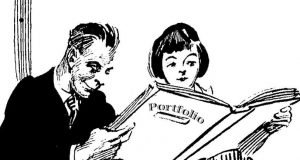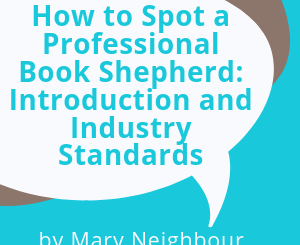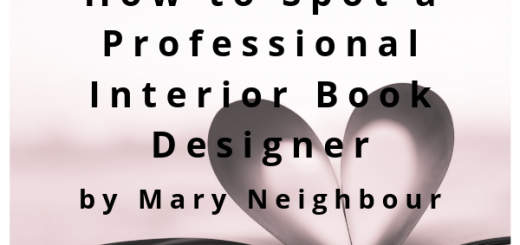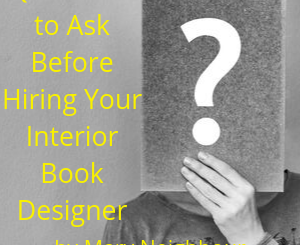Questions to Ask Your Designer Before Hiring: How to Spot a Professional Cover Designer by Mary Neighbour
 Please welcome back guest author Mary Neighbour as she shares with us “Questions to Ask Your Designer Before Hiring: How to Spot a Professional Cover Designer.” Enjoy!
Please welcome back guest author Mary Neighbour as she shares with us “Questions to Ask Your Designer Before Hiring: How to Spot a Professional Cover Designer.” Enjoy!
***
You no doubt will feel excited as you embark on your search for a book designer, anticipating the creation of that irresistible cover, eager to discuss colors and choose fonts. An author may have visualized their cover before ever speaking to an artist.
Likely you’ll interview several before making your final decision. But to conduct a meaningful discussion, bring all your enthusiasm into play as you research candidates for the job.
Question Before Your Start Your Search
How will you find the best match for your book and your budget?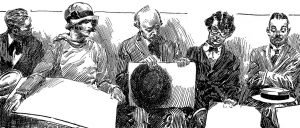
Many start by taking referrals from other authors in their genre, but be sure to cover ground on the internet, as well, beginning with a simple Google image search, using keywords associated with your book.
For example, if your book is for young adults, and the story is about a girl and her horse, you might search: “YA girl horse books,” and the results you get will help you see what other covers look like.
Questions to Ask
Questions to ask:
- Do they use photos or graphic art?
- Do they represent the girl with the horse?
- Are certain horse breeds more popular?
- What types of settings are used?
Some covers may give you fresh ideas for your own book. If you do the same search on Amazon.com, you’ll be able to drill down to the book’s ranking and see which sell well.
Recommended: Visit a library or bookstore to see how books like yours are grouped. Handling physical books is a different experience than viewing tiny, 2-D, online images.
Ask yourself these questions:
- What covers draw your attention first?
- Which ones are the last to get noticed?
Also, ask the librarian or bookstore owner what’s popular.
Allow your impressions to inform your ideas about cover design, and bring these into the discussion with the artists you interview.
Share with the designer both the covers you like and those you do not like.
Start the Conversation
Once you have a short list of designer prospects, start the conversation with each by describing your book’s vitals:
- genre
- title
- synopsis
- what you intend the reader’s experience to be
- how you plan to market the book.
Few artists will have the time to actually read your book, and they’ll likely have their own questions about your message, premises, and themes. Mention early on in the conversation how you anticipate having the book printed and manufactured. Discuss trim sizes.
Continue your interview, asking the following questions
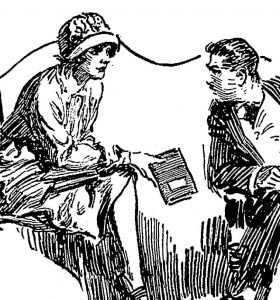 Continue your interview, asking the following questions (answers to which have been covered in previous blogs).
Continue your interview, asking the following questions (answers to which have been covered in previous blogs).
- What other covers have you created in my genre? “I’d like to follow up with those authors as references.”
- Do you offer a written contract covering each of our responsibilities, what you’ll charge, and who owns the copyright on the design?
Tip: It is not uncommon for cover artists to retain the copyright of their designs, or elements of the design (e.g., a photo they took).
Nevertheless, your payment to the artist typically will entitle you to use the design on your cover and related materials, without additional licensing fees. Just get the agreement in writing, and include any limitations on the artist’s use of that design element, so that you protect your book’s brand.
- How many design concepts will you develop? When we settle on a design, will I be able to ask for variations of color and font selection?
Listen for: mention of how the designer handles “creep” in the scope of the work. Because this is a creative process, the work to be done can easily grow beyond the boundaries initially set. This occurrence has been the death knell of many an author-artist relationship.
- I can’t decide yet whether to use a photograph or a graphical design. Can you draft both types?
- What are the licensing issues with the fonts you’ll use?
- I created on my laptop a crude mock-up of my cover concept, but when I printed it out, it looked terrible, especially the colors. What would you recommend to improve it?
Listen for: mention of the role of RGB and CMYK color models.
- Have you worked with book printers before? Have you worked with their cover templates?
Listen for: mention of their experience with printers. In order to position the design correctly on the cover, templates are essential.
- Do you have ideas for tying together the back and spine with the front? Can you show me examples of how you’ve done this in the past?
- What colors are typical for my genre? Should I do something different? Listen for: their answer should reflect their experience with your genre, as well as a basic understanding of the psychology of color.
- I’ve heard that using color gradients is old-fashioned. What do you think?
- Once we have a design, will you give me a physical proof? Recommended: don’t rely on a digital view of the final design. Colors, especially, will look different when the design is printed.
- I’d like to test market the design. Depending on the feedback I get, are you willing to make adjustments? Recommended: If you are able, show the design to people who are not friends or family. Stop by libraries and bookstores to ask librarians and booksellers to react to the cover.
All of the above are intended to initiate discussion on matters that matter. The artist’s answers won’t be right or wrong; rather, they will be revealing.
These questions—in combination with your review of the artist’s portfolio—are sure to help you select the best designer for you and your book cover.
Now you’re ready for one of the most exciting phases of getting your book out into the world!
Next week in this series: we’ll introduce our series of blogs on interior book design.
The following week: “Interior Design Standards.”
***
ABOUT THE AUTHOR
 Some call Mary E. Neighbour a “book shepherd,” though Mary wields a blue pencil far more expertly than a herding rod. For the past ten years, she and her husband have helped dozens of writers bring their manuscripts to the marketplace, through MediaNeighbours, their publishing services business.
Some call Mary E. Neighbour a “book shepherd,” though Mary wields a blue pencil far more expertly than a herding rod. For the past ten years, she and her husband have helped dozens of writers bring their manuscripts to the marketplace, through MediaNeighbours, their publishing services business.
Passionate about helping authors make their work shine in the world, with a combined professional expertise of over 50 years in editing and design, this family team is one you’ll want to adopt as your guide through the challenging world of independent publishing.
Mary’s other passion is learning about the history of slavery and how it impacts race relations today. She incorporated much of her research into her novel, Speak Right On: Conjuring the Slave Narrative of Dred Scott

